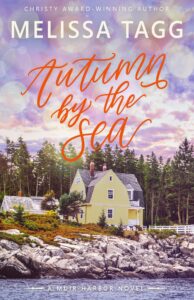by Melissa Tagg, @Melissa_Tagg
I love a good plan.
I mean, like, really love. At my marketing day job, I never start a workday without a task list. When I’m feeling overwhelmed with busyness, one of the things that helps me most is sitting down with a calendar and a list and simply figuring out what I’m going to do when.
And when it comes to writing, although I’m not a massively detailed outliner, I do love to have a solid plot in place before I start writing. I put my main characters through the SEQ. I know what my story’s tent poles are. I usually know what I’m writing toward.
BUT . . . some of the most fun I’ve ever had with writing is when a plot suddenly veers, when a character does or says something I didn’t plan, and when my own story surprises me. I looooove those moments.
But they’re also tough because they require changing the plan. Sometimes they require going back and rewriting old stuff or scrapping an entire subplot or branching out to somewhere you never meant to go. Every single time I’ve done that, the extra work has totally been worth it.
With my most recent book, more than ever, I wanted to let myself go with the flow as I wrote. I wanted to be surprised because I figured the more I could surprise myself, hopefully the more I’d surprise the reader. Through the process of trying to be a bit of a pantser in my usual plotter world, I’ve come up with a few practical tips to help myself (and maybe you!) along:
- Make the decision. Recently, I was just stepping into the “messy middle” of my current WIP when I realized the story could veer off into a new place that might be kind of fun. But it didn’t have to. I could ignore that little voice saying, “Ooh, ooh, what if?!” in the back of my head and stick to my plot. But I decided to loosen my grip. I decided to let the story go where it wanted and oh my goodness, it got twisty and tangled…and FUN. Instead of fighting it and continually trying to tug the story back to where I’d originally meant for it to go, it was freeing to make the decision and go with it.

If you’re having trouble making the decision, though . . .
- Talk it over with a writing friend. I have a good author friend I chat with pretty regularly and I can’t count the number of times I’ve said to her, “Does this sound totally crazy to you?” Often just processing my surprise story beats out loud helps me know what I want to do…even before she’s replied!
- Look back. When you surrender to a plot twist or new story thread you didn’t see coming, you’re going to need to look back to make sure what you’ve already written supports your new direction. You might want to go back and make changes right then or, if you’re the fast-drafting type, you might open up a Word doc and spill a bunch of notes so that you know what you need to go back and fix later.
- Look forward. This is where your plotting brain comes back into play. With the book I’m revising right now, something happened about 70% of the way through that changed the trajectory of the story from there on out. But I didn’t want to slow way down and go back to the plotting drawing board. So instead, I spent one hour with a Word doc and just typed out everything that would need to happen from that point on. It was so helpful just to do a brain dump and then get on with it! The perfect balance of giving in to a lightbulb pantsing moment while also keeping my plotting side comfortable.
- Don’t overanalyze. A friend and I have been talking about this a lot lately—about how sometimes the thing that holds us back the most when it comes to writing is overanalyzing every little thing. And this could really hamper you when you’re trying to let the story breathe a little and go with the flow.
I think one of the best ways to keep yourself from overanalyzing is to go back to the spark. What was the thing that pinged in your brain that got you to step off your original course? What excited you in that moment? Remember that and let it pull you away from analysis paralysis and back into the fun of discovering your story.
Abandoned as a toddler, Sydney Rose has spent years wondering who she really is, homesick for a life she’s never lived. When a private investigator crashes into her world, she finds herself heading to a tiny seaside town in Maine to meet a woman named Maggie, who’s searching for the granddaughter she lost decades ago.
If not for Maggie, Neil MacKean might still be back in Scotland, bereft and alone. Instead, he has a full life in Muir Harbor with an adopted family he loves and a blueberry farm to run. But the farm is struggling and strange occurrences have him concerned. Worse, Maggie’s once again caught up in the past, convinced she’s finally found her long-lost granddaughter.
Worried for Maggie, Neil is suspicious of the city girl who shows up at the farm. But there’s something about Sydney that tugs on him, drawing out secrets he never meant to share. While Neil grapples with the future of the farm, Sydney wrestles with a past that’s messier than ever. Together, they’re pulled into a mystery complete with a centuries-old legend, unexpected danger . . . and a love as deep and wild as the sea.

Melissa Tagg is the USA Today bestselling, Christy Award-winning author of swoony and hope-filled small-town contemporary romances, including the Muir Harbor series, the Maple Valley series, and the Walker Family series. She’s also a former reporter, current nonprofit marketing strategist, and total Iowa girl. Melissa has taught at multiple national writing conferences, as well as workshops and women’s retreats. When she’s not happily lost in someone else’s book or plugging away her own, she can be found spoiling her nieces and nephews and daydreaming about her next fictional hero. Connect with Melissa at melissatagg.com.


